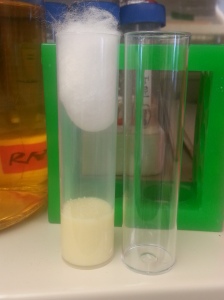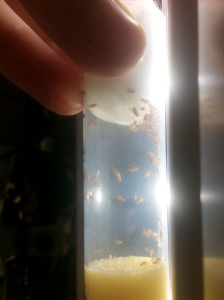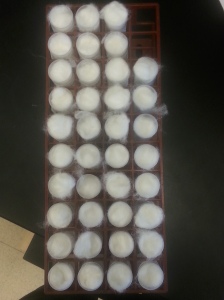Author for this post: Travis Parsons, Ph.D Candidate
One inconvenience of rearing Drosophila is that since they carry unique genetic mutations that often take large amounts of time and effort for researchers to generate, labs chose to maintain many of their flies (or “stocks”) indefinitely rather than let them die. This is especially true in the case that a certain fly strain has been published in a scientific paper. Labs have the responsibility of keeping that genetic line alive so other researchers may request it, or use it in their research, or characterize it further. This helps to prevent scientific fraud.
Keeping flies alive takes a significant amount of time and effort for researchers. In our lab, every senior lab member spends roughly 2 hours keeping their flies alive per week. This also carries the drawback of having to plan vacations and time off carefully – the flies don’t stop their development to wait for you to return.
Many labs in the past used to raise flies in glass bottles, but this is very inconvenient when you have thousands of stocks and have to wash every bottle. Now, labs use plastic vials and bottles that are disposable. Seen below is a typical vial we use in our lab with a quarter for scale. The top is plugged by cotton or rayon, which prevents flies from escaping the vial (as well as keeps other flies out – remember, every fly strain is a purebred mutant. If any other fly gets in, the entire stock is contaminated. We keep 2 copies of our stocks in case an issue arises with 1 copy).

Even the plastic used for rearing flies is an important consideration. Other options exist that are more translucent, but these vials are more brittle and food dries out more rapidly in them.

The bottom of the vial is filled with Drosophila food, which is what the flies and larvae eat as well as what they lay their eggs in. Our lab makes giant batches (Tens of liters) of fly food every week that consists of water, yeast, soy flour, cornmeal, agar (essentially a gelatin like substance), light corn syrup, and propionic acid. We also sprinkle extra yeast on top of the food.

We keep large stocks of our fly food reagents on hand, as we go through them rapidly. We freeze them to prevent other organisms such as mites from contaminating our cultures.

When we want to grow larger amounts of flies in one vessel, we use bottles.

When flies are first ‘flipped’ or ‘pushed’ into a new vial, it looks something like this:

From this point, the rate at which the flies develop depends on the temperature you keep them at. Most fly labs have sets of incubators at 18°C, 22°C, and 25°C. At 18, flies take ~18 days to develop to adulthood. At 22, it takes ~11 days. At 25, flies take ~9 days. This means most flies can stay in 18 for long term storage for about a month before we must change their food and vial.
During these time periods, the adult flies lay eggs in the food. These eggs hatch and larvae emerge. The larvae crawl into the food and eat large amounts of food as they exponentially increase in size. During this time, cells that will later become the adult fly begin to multiply. Afterwards, the larvae crawl out of the food and up the sides of the vial, where they turn into pupae and begin to metamorphose. Days later, adult flies emerge from the pupal cases.
The below picture shows a vial that has these life stages present in it.

The white objects on the walls of the vial or bottle are larvae that have crawled up the side of the vial and are ready to pupate. The darker objects are flies that have already done so. The lighter food at the bottom is food that no larvae have been able to reach or eat, while the darker food on top is full of larvae eating and churning up the food.
Over time, the food is used up and the vials become crowded and flies must be flipped into new vials. At this point, older flies have died, and younger flies have been born. They are transferred and the process begins anew.
This is multiplied across every fly stock a lab maintains, which are organized in racks.

Some universities such as Indiana University have a Drosophila stock center where they maintain massive amounts of stocks for other labs to requisition. At the time of writing, the Bloomington Stock Center lists 58,967 stocks that are available for order. Assuming they have backups which they surely do, that doubles to 117,934 stocks. That’s 2,945 of the racks in the above picture. If they spend only 30 minutes flipping the stocks in each rack, that means the Bloomington stock center alone spends ~1,474 hours (or ~48 days) flipping their flies every month.
Hopefully this provides a window into how Drosophila are reared in the lab, and why it takes a significant amount of time, money, and effort.











